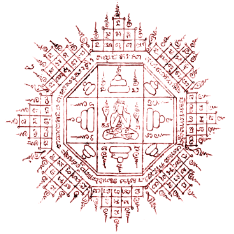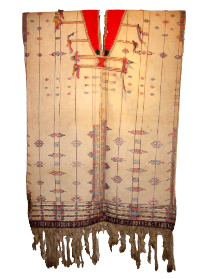Bhutanese Textiles: Weaving from the Heart
Hosted by the Asian Cultural Center of Vermont
July 14th-August 12th, 2007
























Leki la and Sarah.
Leki is a master Bhutanese weaver who was invited to attend the exhibit and give demonstrations. Sarah is a local textile enthusiast who was happy to see the exhibit and learn more about Bhutanese textiles and culture.
Gallery 1
The show sponsored by the ACCVT was displayed at the CX Silver Gallery in West Brattleboro, VT.
Gallery 2
The Gallery is in an old VT farmhouse so the rooms are small. It was a challenge hanging such large pieces in a space like this but with creative techniques we came up with solutions.
Gallery 3
Tunics were mounted on wooden dowels that were covered in mylar to prevent anything from contaminating the textile. Other textiles had membranes carefully sewn onto them and Velcro sewn on to the membranes, in turn attached to the wall. This helped support the weight of the textile evenly.
Full dress form
Having a dress form helped explain to the public how the traditional outfit is worn. Many visitors like to walk around it and admire the wrap.
Torie Olson
is a local well known photojournalist and also a contributing editor to Wildfibers Magazine. Her work helps bring life to the textiles. “Olson’s Photographs charmed viewers with a sparkling humanity that distinctly reveals Bhutanese culture” Susan Avila, Fiberarts Magazine.
Woman’s kira
This is the traditional full length dress for Bhutanese women. It requires a complicated wrap that is anchored by heavy pins at the shoulders. This blue background type of kira is called ngosham.
Man’s full outfit
By mounting it on the wall we were able to show many of the things associated with men together with his tradition dress.
Rare tunic called kushung
Tunics like these predate the wrap style kira dress that Bhutanese women have been wearing for the last 100 years.
“Lady with Guavas”
All Torie’s work is copywritten and cannot be used in any manner with out written consent from Torie Olsen.
Accessories
Included in this exhibit were small accessories to show what a man carries in his robe. Shown here are betel nut and lime boxes, a leather pouch with old copper coins and a traditional food basket. Shown hanging is Torie’s “Ladies in Festival Finery”
Kushutara
This example is called a kushutara because of its white background color. Not having enough wall spaces forced us to hang some of the textiles vertically. We draped this kira over a mylar wrapped dowel and attached the velcro membrane to the face side of the textile and then attached that to the wall, giving us a more balanced weight support, rather then sewing in a pocket.



